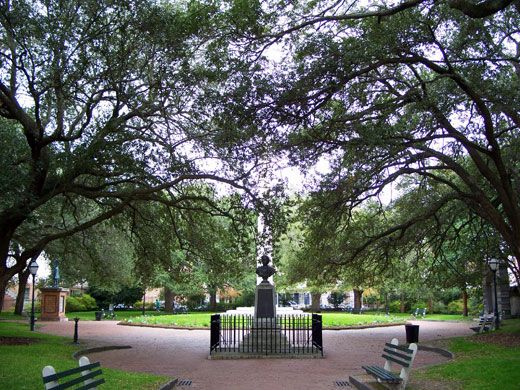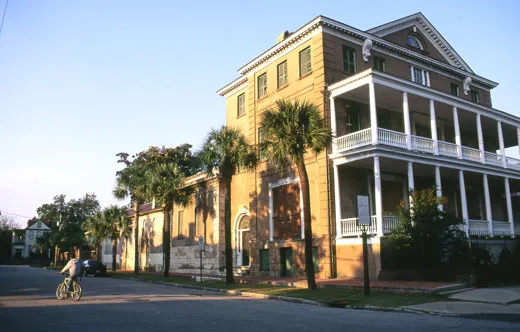My Kind of Town: Charleston, South Carolina
Novelist Josephine Humphreys says the city is more than just her hometown, it’s her life
/https://tf-cmsv2-smithsonianmag-media.s3.amazonaws.com/filer/Aiken-Rhett-House-Charleston-South-Carolina-631.jpg)
One spring afternoon I was sitting at my office desk when I heard the sounds of a ruckus outside. And I do welcome a ruckus. My office is on the ground floor of the Confederate Home, where widows lived after the Civil War and old ladies still live today, with the extra studio apartments rented to artists and writers. It's a quiet place hidden away in the busy heart of town, amid lawyers and tourists and Charlestonians out for a stroll. In good weather I leave my two big windows open, knowing something interesting will waft in from Chalmers Street. If I'm lucky it might be oompah music from nearby Washington Park, or a snippet of conversation from passersby who're unaware that I'm only three feet away and may well weave their snippet into what I'm writing. The noise on this particular afternoon was new: a clomping and a hollering. I looked down the street and saw a company of Union soldiers marching my way, attracting the stares of onlookers.
Suddenly the spectators turned on the men in blue, hurling first insults and then projectiles. One big brick struck a soldier in the head, and he fell to his knees with a hand over his bleeding ear. When the brick hit the street, it didn't behave like a brick at all. It bounced. Aha. Better than a ruckus, a movie! Pretty soon everyone recovered, and Makeup came to clean up the fallen soldier.
I count myself lucky to have been born in a town that's rife with contradictions, a difficult past in constant need of retelling, and real characters. Moviemakers seem to love the place. Who would not, seeing for the first time these old tall houses with their unique side porches, the streets lined with palmettos and live oaks, the muted sunlight filtering down through sea mist and humidity? We're called the "Holy City" for our skyline of steeples, and we were named America's "most well-mannered city" 11 times by the late doyenne of etiquette Marjabelle Young Stewart. Visitors notice all this beauty and politeness and history. Sometimes I do too, but more often I can't clearly see anything at all, or at least not in any pure or definable form that could lead to a sobriquet or a superlative. This is because I've lived my whole life here. I know too much. Nothing I see is simply scenery or event, but all is overlaid with memories, and those memories with other memories and stories, plus the truth of history as I've learned it over time, and finally with a film of dreams and losses, bits of music, discoveries, tragedies, wild comedy and fragments of desire. I never think of Charleston as my "hometown." I don't know what I should call it, except maybe my life.
You'd think that a lifetime spent in one town would lead eventually to understanding or at least to boredom (if those two things are not the same). That has not happened. I can still be surprised, for instance, by coincidences, by abrupt outcroppings of irony or by the way history bubbles up in one form or another. Often it's Civil War history, given the local obsession, but it can also be my own.
Last November another movie was filming farther uptown at Read Brothers store, on the corner of Spring and King, where I'd gone under the pretense of buying a bedspread. Read Brothers is the strangest store you'll ever see, a big red-brick, creaky-floored building stocked primarily with fabric but also with used books, vintage toys, folding paper fans, long johns, foam rubber and high-end stereo equipment. I like to drop in periodically to get inspired by the wacky plenitude. Evidently, the movie director was similarly inspired when he chose the store as a setting. Whether the scene was action or romance didn't matter; Read Brothers looks like a place where anything could happen. The line between then and now is thin. Some of that merchandise has been on the shelves for decades. I asked the owner, Marianne Read, what the oldest item in the store was, and without missing a beat she reached into a basket on the counter and grabbed a card of hairpins, "Victory Bobbies," vintage World War II. I bought them for a dollar and asked if I'd gotten the last set. "Oh, no," she said. "We have cartons and cartons in the storeroom."
It was reassuring to think of those extra cartons, surely an eternal supply. I realized that Read Brothers mirrors my image of Charleston itself: a place packed with oddities and treasures that will never be depleted. Or maybe I was really thinking about my own self, desperately hoping my brain will prove to be similarly provisioned for the future. But just as I was leaving Read Brothers I noticed that the stock of merchandise on the main floor seemed a little thinner than it used to be. In a corner where once my childhood friend Pat and I used to select fabric for our dance recital costumes, choosing from shelves and shelves of bright tulle and satin, now the supply of the spangliest and glitteriest had dwindled to a dozen or so bolts. I pretended not to see that. I want Read Brothers to live forever.
Those bobby pins are basically my age. I was born in 1945. The three houses where I grew up are all just a few blocks from my Confederate Home office, and Chalmers Street, which in my childhood formed a line between well-mannered downtown and a more variegated (and artier, wilder, more interesting) uptown, was my main playground. On the corner was the Fireproof Building, which as a child I never entered; it housed historical documents and didn't welcome children, as if History were something that could be destroyed not only by fire but by children. But in adjacent Washington Park, I played every afternoon with Pat, who lived just over the wall, and there was plenty of history for us in the park: not only the scaled-down replica of the Washington Monument (this one dedicated to Confederate soldiers), but also monuments commemorating the poet Henry Timrod; Francis Salvador, the first Jew elected to public office in America; and Elizabeth Jackson, mother of Andrew Jackson. Pat and I roller-skated around these monuments and memorized their inscriptions, which seemed to suggest to us a rich variety of histories. Sometimes we sat on a bench under giant live oaks and watched the comings and goings of lawyers on the way to City Hall. Beyond Pat's house was the Confederate Home, which I rather feared at the time, knowing that it housed old ladies. Charleston's old ladies ruled the town, and if you misbehaved within the hawkish eyesight of one, as Pat and I did once when we skated into the street instead of staying in the fenced park, you'd be in for a tongue-lashing even if the old-lady spy was not one you knew personally.
I don't remember ever hearing the word "woman" spoken in my early years. Is that possible? There were basket ladies, literary ladies, cleaning ladies, flower ladies, artist ladies, ladies of the evening. And two-block cobblestoned Chalmers Street had seen them all. At No. 6, two eccentric and valiant old ladies ran, on their own shoestring, the Old Slave Mart Museum, the single place I encountered where the shocking reality of slavery (human beings were bought and sold here) was acknowledged as part of our history. No. 17, "The Pink House," was the studio of Alice Ravenel Huger Smith, who painted idyllic watercolor landscapes of slaves at work on hazy pastel plantations; but in an earlier age the building had been one of the city's many bordellos. At No. 36, there lived one old lady whose presence in town would shape my future: Josephine Pinckney, the only flesh-and-blood novelist I had glimpsed, and aside from a great-aunt, the only other Josephine I'd heard of.
Today, I can spend long hours in the Fireproof Building, reading documents and manuscripts in the library of the South Carolina Historical Society. I like to dig up the stories of people who never made it into history books. At lunchtime I might eat a hot dog in Washington Park and hope to spot a bit of romantic drama in the corner behind City Hall; sometimes the couples who've just gotten a marriage license will scoot out back for a speedy wedding under the oaks, and I can watch the little scene while a story spins up in my head. Or maybe I'll walk on down Chalmers, past the building where Pat and I learned to tap-dance at Miss Mamie Forbes' Dancing School, on to the recently reopened Old Slave Mart Museum, where my friend Nichole is curator. Sometimes we eat lunch on the same bench that was Pat's and mine more than half a century ago.
Pat moved to California in the seventh grade. I don't know what happened to her, but I think of her as the antithesis of me, adventuring a continent away while I stayed home and steadily, with each day's passing but to my infinite surprise, gradually became one of this old town's old-lady spies myself. In the process, the place has grown more mysterious to me, richer in connotations and complexities, more likely to make understanding impossible. At the same time, what becomes possible is a kind of minor revelation, the kind that artists and writers need from time to time. A spur, a seed, the start of something: maybe a reverie, maybe a book.
Remarkable coincidences sometimes happen when you're ready for them. One week ago I took a break from writing about Charleston to go browsing for books, and I saw a new calendar for sale, one that illustrates each month with a sepia-toned photograph from History. The cover photo caught my eye. A suspiciously nostalgic picture, I thought, and therefore maybe not trustable. Girls on a bench...sassy pals, full of confidence, not realizing what lies ahead or even that anything does lie ahead. It took me more than a few seconds to understand that this was a picture of me, circa 1952. I'm sitting on the bench in Washington Park with my old friend Pat and a younger girl I don't recognize. It's a photograph I'd never seen before. I bought the calendar and showed it to my family. My husband says it could be me, my sister says not, but I'm saying I'm sure of it. I'm saying that was me.
Josephine Humphreys' novels include Nowhere Else on Earth and Rich in Love.
Planning Your Next Trip?
Explore great travel deals
Smithsonian magazine participates in affiliate link advertising programs. If you purchase an item through these links, we receive a commission.

